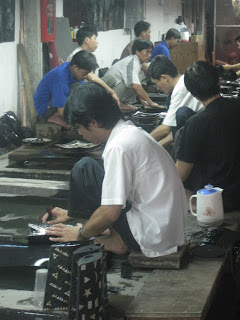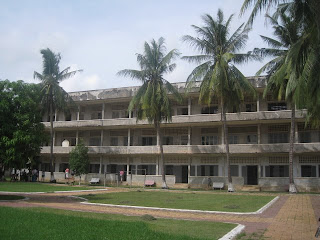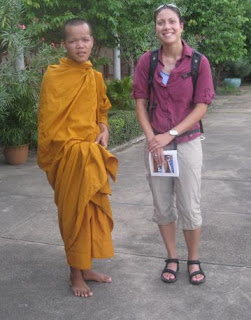I spent one day at Sihanoukville learning traditional Khmer cooking from a friendly local chef. Cambodian cuisine is typically less spicy than that of its neighboring countries, but it relies on many of the same flavorings: coconut, lemongrass, ginger, basil, mint, lemon/lime, turmeric, chili, garlic, shallots, and the ever-present fish sauce. Over the course of the day, we made four popular and very tasty dishes: beef lok lak, banana flower salad with steamed chicken, fish amok and pumpkin custard.

My friendly - and very patient - teacher prepares banana flower for a salad

Beef lok lak is cooked in a modified oyster sauce and served with a salt, pepper and lime juice dressing. It is typically accompanied by steamed rice.

Banana flower salad with steamed chicken, served in a banana flower petal. The sweet, salty and tart dressing can also used for green papaya or green mango salads.

Fish amok, steamed in banana leaf, is a Cambodian specialty, often served with rice. It doesn't look like much here, but the combination of ginger, turmeric, shallots, chili and coconut milk can't be beat. Amok can also be made with chicken, prawns or tofu.

Custard steamed in a pumpkin shell makes a nice end to a meal, although my favorite Cambodian dessert is sticky rice with mango
 The very colorful Cao Dai Holy See temple outside of Saigon; the Cao Dai faith combines elements of Christianity, Buddhism, Confucionism and Taoism, among other religions
The very colorful Cao Dai Holy See temple outside of Saigon; the Cao Dai faith combines elements of Christianity, Buddhism, Confucionism and Taoism, among other religions Worshippers gather four times daily for prayers at the temple
Worshippers gather four times daily for prayers at the temple Cao Dai followers kneel in prayer during a noontime service
Cao Dai followers kneel in prayer during a noontime service Traditional Vietnamese musical instruments on display at the History Museum
Traditional Vietnamese musical instruments on display at the History Museum Workers prepare pieces for lacquering at a factory outside of Saigon
Workers prepare pieces for lacquering at a factory outside of Saigon A crocodile eyes visitors at the Saigon Zoo
A crocodile eyes visitors at the Saigon Zoo
 An underground war room beneath the palace; there are two complete underground bombproof levels where the president and his staff could remain while under attack
An underground war room beneath the palace; there are two complete underground bombproof levels where the president and his staff could remain while under attack The view from the palace down Saigon's tree-lined Le Duan street
The view from the palace down Saigon's tree-lined Le Duan street A man demonstrates how Cu Chi guerillas would enter their network of tunnels and cover their tracks. The Cu Chi tunnels stretched for miles from Saigon to Cambodia (with meeting rooms, kitchens, storage and triage areas) and played an important role in the war.
A man demonstrates how Cu Chi guerillas would enter their network of tunnels and cover their tracks. The Cu Chi tunnels stretched for miles from Saigon to Cambodia (with meeting rooms, kitchens, storage and triage areas) and played an important role in the war. A U.S. Army tank on display at the War Remnants Museum in Saigon
A U.S. Army tank on display at the War Remnants Museum in Saigon Cheerful paintings by Vietnamese schoolchildren contrast the horrifying photos of the war at the War Remnants Museum in Saigon
Cheerful paintings by Vietnamese schoolchildren contrast the horrifying photos of the war at the War Remnants Museum in Saigon A bicycle laden with baskets, on a side street in Saigon
A bicycle laden with baskets, on a side street in Saigon Motorcyclists prepare for a rush at the green light; in the background, a poster of Ho Chi Minh adorns a city park
Motorcyclists prepare for a rush at the green light; in the background, a poster of Ho Chi Minh adorns a city park These look like hats, but they're actually motorcycle helmets cleverly disguised as hats. Saigon residents take motorcycle riding to new heights of fashion!
These look like hats, but they're actually motorcycle helmets cleverly disguised as hats. Saigon residents take motorcycle riding to new heights of fashion! I was constantly amazed by what people were able to carry on a bicycle or motorcycle. Equally amazing was where people rode them - in every lane of traffic, between cars and even up on the sidewalk!
I was constantly amazed by what people were able to carry on a bicycle or motorcycle. Equally amazing was where people rode them - in every lane of traffic, between cars and even up on the sidewalk! Cars and trucks, left two lanes; motorcycles and cyclos, right lane
Cars and trucks, left two lanes; motorcycles and cyclos, right lane Street vendors tote large coolers with drinks around the city
Street vendors tote large coolers with drinks around the city
 Bonsai trees in the downtown botanical garden and zoo; the garden offers a welcome escape from the city's chaotic streets
Bonsai trees in the downtown botanical garden and zoo; the garden offers a welcome escape from the city's chaotic streets The ornate central post office, next door to Notre Dame Cathedral
The ornate central post office, next door to Notre Dame Cathedral Good luck statues and bills for sale at Saigon's bustling Ben Thanh market
Good luck statues and bills for sale at Saigon's bustling Ben Thanh market


 In addition to the tuk-tuk and motorcycle taxi popular elsewhere in Cambodia, Phnom Penh has the "cyclo" - a kind of bicycle-rickshaw that braves the crowded city streets alongside buses and trucks
In addition to the tuk-tuk and motorcycle taxi popular elsewhere in Cambodia, Phnom Penh has the "cyclo" - a kind of bicycle-rickshaw that braves the crowded city streets alongside buses and trucks Phnom Penh is lcoated at the confluence of the Tonle Sap and Mekong Rivers. Families gather on the riverbank at dusk to play soccer or watch the sunset.
Phnom Penh is lcoated at the confluence of the Tonle Sap and Mekong Rivers. Families gather on the riverbank at dusk to play soccer or watch the sunset.
 The National Museum of Phnom Penh, opened in 1920 by King Sisowath, holds historical artifacts from across the country, including some of the best statuary from Angkor Wat
The National Museum of Phnom Penh, opened in 1920 by King Sisowath, holds historical artifacts from across the country, including some of the best statuary from Angkor Wat  Young monks pause to feed the fish in the courtyard of the National Museum
Young monks pause to feed the fish in the courtyard of the National Museum
 Many of the school rooms were divided into tiny cells; other rooms were used for torture and interrogation
Many of the school rooms were divided into tiny cells; other rooms were used for torture and interrogation
 A giant memorial stupa in the center of the Choeng Ek killing fields holds thousands of unearthed skulls and bones of the people who were brutally killed by the Khmer Rouge; to the left of the photo is one of the marked mass graves
A giant memorial stupa in the center of the Choeng Ek killing fields holds thousands of unearthed skulls and bones of the people who were brutally killed by the Khmer Rouge; to the left of the photo is one of the marked mass graves
 Skulls in the memorial stupa at Choeung Ek
Skulls in the memorial stupa at Choeung Ek The Royal Palace was built in 1866 for King Norodom and his family; the building in the foreground is the dancing hall
The Royal Palace was built in 1866 for King Norodom and his family; the building in the foreground is the dancing hall The buildings within the palace compound are ornately decorated with wood carvings and paintings; the yellow color represents Buddhism
The buildings within the palace compound are ornately decorated with wood carvings and paintings; the yellow color represents Buddhism

 The Royal Palace is a popular destination for tourists and locals alike. This young monk, who was visiting with a group from his monastery, asked to have his photo taken with me.
The Royal Palace is a popular destination for tourists and locals alike. This young monk, who was visiting with a group from his monastery, asked to have his photo taken with me.














